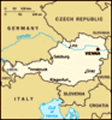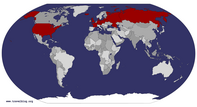Advertisement
Published: April 19th 2009
... tired old
Sound of Music jokes when talking about Salzburg?
Actually, much credit goes to Greg for "going native" and appreciating Salzburg in the proper European manner: as the first home of Wolfgang Amadeus Mozart. At the end of our trip, he even commented that were it not for Mozart, tourists might not visit Salzburg at all! Meanwhile I'm humming "Edelweiss" (hint: not a traditional Austrian tune) and trying to remember where-all the von Trapp children danced during the "Do Re Mi" montage.
OK, I only did that a little bit. 😊
ÖBB offers a high-speed direct route, under three hours from Wien (Vienna) to Budapest, Hungary on their
RailJet line. We seriously considered making a day trip there, but ultimately decided that such a large city with so many compelling sights deserves its own trip and at least several nights' stay.
But then I discovered that Salzburg was about the same distance away (in the other direction). I've been to Salzburg before (
So long München, hallo Salzburg....), and the Altstadt (old town) is
tiny. I felt confident it'd be easy to see as much as we wanted in a day (though the cheezy
Sound of Music van tour would
have to be sacrificed).
The reason Salzburg didn't occur to me sooner is that it's much closer to München (Munich, Germany) than it is to Wien. In fact, Salzburg was originally founded in 699 as part of
Bavaria (now a German state) at Juvavum, a Roman ruin. Starting in the 14th century it became an independent Prince-Archbishopric, finally joining Austria only in 1816. All of this suggests that my other favorite thing about
The Sound of Music, its emotional themes of Austrian nationalism and traditionalism, are a little suspect also. On the one hand, the breakup of the Austro-Hungarian Empire at the end of WWI, which rendered poor Navy Captain von Trapp landlocked and irrelevant, may have been a truly traumatic event for loyalists as depicted in the film. But the free-spirited Salzburgerin Maria embodied Austria for the Captain, while the Viennese Baroness' big-city ways were practically foreign to the Captain's vision of Austria? Strange, since Vienna is Austria's capital and Salzburg came late to the party!
And that's all the
SoM we will be indulging in today. 😊
This morning we had to get up at null-dunkel-dreißig ("oh-dark-thirty"... yes, I just made that up) to catch
our early Inter-City Express (
ICE) train. I must say residual jet lag came in quite handy this time, making it easy to sleep early and rise early. ICE trains are super-comfy as long as they are not too crowded. Ours was not at all crowded. We even got seats at a table, where Greg was able to work on composing his Mass and I got to get in the Salzburg spirit by listening to some Mozart symphonies and his Requiem on Greg's iPod.
We left too early for breakfast at our Pension back in Wien, so we planned to indulge in a fancy restaurant breakfast when we arrived. Good call. A little web research pointed us toward
Café Mozart on Salzburg's historic pedestrian shopping street called Getreidegasse (literally, "grain lane"! no kidding!), where we had almost the entire restaurant to ourselves. I had scrambled eggs, smoked salmon, fresh rolls, coffee, orange juice and a small glass of champagne. Greg chose a more traditional soft-boiled egg with wurst and cheeses, and skipped the bubbly.
After breakfast, we found Mozart's birthplace just a few doors away. The sun was shining, and a handful of tour groups (Italian and Chinese, as best

 Feh!
Feh!
These tissues neatly sum up Greg's feelings about his allergies today.I could tell) were gathering in front. The Mozart family thoughtfully arranged for Wolfgang to be born in an apartment with a small square in front, making it easy for visitors 300 years later to step back and get a very nice photo of the entire front of the building. The Getreidegasse and most other lanes in the Altstadt are so narrow that almost no other address offers such a view!
As a museum,
Mozarts Geburtshaus is a pretty well-known bit of a letdown. Greg put his finger on the cause, I think: the Mozart family
moved out of this place in 1773, when Mozart was still a teenager. Naturally, they took their stuff with them. The museum tries hard to make the most of its historic space, but many (most?) of the exhibits aren't even directly related to Mozart and as far as we could tell, the Mozart artifacts were all reproductions or approximations. They just don't have that much to work with. I still find it inspiring to walk through the actual space, but I was looking forward to the much better Mozart-Wohnhaus on the other side of the river.
After the Geburtshaus, we walked a bit
in the Universitätsplatz (University Square), checking out the farmers' market stalls, only one of which was actually selling farmers' produce... the rest offered Imbiß (fast food), crafts, and souvenirs. Perhaps they've figured out that tourist guidebooks were recommending the farmers' market. At a tobacco shop in a nearby Durchgang (passageway), Greg found a German translation of a book by his favorite author, Robert Heinlein. We wandered through Salzburg's interconnecting squares and explored the Salzburger Dom (Salzburg cathedral), Franziskanerkirche (Franciscan church), Friedhof St. Peter and Peterskirche (St. Peter's cemetery and church). It was funny for me being inside the Salzburger Dom; having photographed the heck out of it in 2005, I struggled to find photos I hadn't already taken. Historically-preserved sites not changing very much is kind of the point. 😊
We moved on to find more Mozart. Greg had previously indicated that he wanted to see Mozartplatz (Mozart Square), but only if it wasn't too out of our way, as the map showed it on the far end of town. Did I mention Salzburg is tiny? Yeah. Couple hundred meters' walk from where we were. Seriously.
Thanks to the wonderful off-season, the Mozartplatz was nearly empty when we

 Store room?!
Store room?!
Gotta store the banners somewhere... which one of the exquisite chapels should we choose?arrived, and we had plenty of time to get all the photos of Mozart's statue we could possibly want before one small tour group arrived to take theirs. We easily found seats on benches in the square and stopped to relax for a while, watching the Chinese tourists take turns posing with Herr Mozart's bronze likeness and the lovely Alps beyond.
On the nearby Judengasse ("Jewish lane"), Greg spotted a tiny orange restaurant advertising traditional Austrian cuisine and jumped at it. We had already placed our order before Greg noticed, on the wall right above my head, a framed photo of the owner with Rick Steves! Saran Essbar wasn't in my 2005 copy of the guidebook, which we had with us; Rick added it in the 2006 edition. Lunch was delicious, but the aromas from the table next to us made me wish I'd tried one of the Asian fusion dishes instead of Schnitzel.
Greg really wanted to find
Sporer, a
Schnaps distillery on the Getreidegasse which is prominently and charmingly featured in Rick Steves' Salzburg episode. We ended up having a better time there than Rick did! The entire shop is about the size of my kitchen,
with a narrow stand-up bar where locals really do stand and sip Schnaps, and the sampling area is located just beyond. The kindly Frau behind the counter stood ready to assist us, but we didn't know where to begin, and that's when an honest-to-goodness Austrian gentleman (Tirolean hat, yes; vest, yes; Lederhosen, no) stepped in to provide guidance. He told us the Marillen (apricot) Schnaps was perhaps the most authentically Austrian, made from locally-grown fruit. He also recommended the Hausmischung ("house mixture"), an herbal digestive that is Sporer's exclusive specialty. We loved talking with him and Greg bought a small bottle of the Hausmischung. I don't know if it would have made sense to try to stay in touch with the gentleman, but I regret not asking. Greg regrets not buying more Schnaps; we forgot to look for more in Wien until Sunday, when it was too late, and we definitely cannot find anything like it here at home.
We crossed the Makartsteg pedestrian bridge over the Salzach River, to Makartplatz where the
Mozart-Wohnhaus (Mozarts' residence) museum is located. I love this museum, and Greg liked it well enough, but it was noteworthy that he's so well-studied on his
favorite composers that any general-public museum, for the most part, will be dedicated to information he already knows. My own visits to this and other museums also suggest that fatigue and serious foot pain will take the luster off of almost any exhibit, and we were both experiencing those symptoms by that point.
As more-or-less planned, we called it a day in Salzburg and headed back to the Hauptbahnhof (main train station) to catch one of the plentiful direct trains back to Wien. I stopped at the Deutsche Bahn InfoCenter to check whether seat reservations were recommended for this train... you can save a few Euros by skipping this step and you'll still get where you're going, but you may have to fend for yourself for a seat and it's possible you'll end up sitting on the floor or in between cars (yes, it's enclosed, and some of these spaces even have jump seats). I've done this before and I did not like it. We spent the cash for a little peace of mind. Sort of. Instead of a modern, comfy ICE, we took an older EuroCity (EC) train, the classic European image of a train with a narrow
hallway down one side and individual six-seat compartments on the other. I think of Agatha Christie, but younger folks would recognize the Hogwarts Express. 😊 So on the ICE, seat reservations are managed electronically, and a little LCD panel above each seat is updated in real-time to indicate whether the spot is "reserviert". But on the EC, reserved seats are marked with little printed slips of paper. We had purchased our reservations so recently that the conductor couldn't possibly have had time to mark our seats, so we reached them and found Austrians already occupying them. We were only able to convince one of the two to give up his (our) comfy aisle seat; the other one helpfully pointed out that the less-comfy middle seat was free and extremely pleasantly invited us to use it instead. (The older gentleman who had to move gave the Deutsche Bahn conductor an earful when he came around to punch our tickets; he was upset that the "reserviert" cards weren't in place. My favorite part of the exchange, which took place entirely in German, was when the conductor shrugged and said, by way of explanation, "Deutsche Bahn!")
I don't think the EC experience
would have been very much improved by us putting up a fight about the middle seat. Some EC trains have "reclining" seats, but ours didn't. They were blessedly wide enough, but short, and since Greg and I didn't get to sit across from each other, we couldn't share legroom. Next time, I might choose to wait a couple more hours for an ICE.
Overall, I loved Salzburg, again. Visiting a small, somewhat-familiar city was like catching my breath after a few days' disorientation in Wien. Even though its sights can be thoroughly seen in about two days, and I've already seen most of them, I'm sure I'll go back.
Advertisement
Tot: 0.232s; Tpl: 0.017s; cc: 9; qc: 27; dbt: 0.0676s; 1; m:domysql w:travelblog (10.17.0.13); sld: 1;
; mem: 1.1mb










